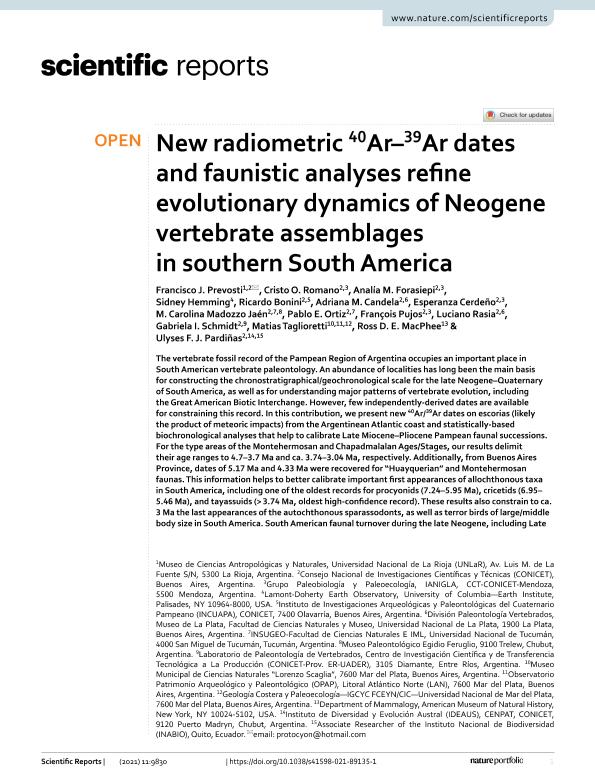Artículo
New radiometric 40Ar–39Ar dates and faunistic analyses refine evolutionary dynamics of Neogene vertebrate assemblages in southern South America
Prevosti, Francisco Juan ; Romano Muñoz, Cristo Omar
; Romano Muñoz, Cristo Omar ; Forasiepi, Analia Marta
; Forasiepi, Analia Marta ; Hemming, Sidney; Bonini, Ricardo Adolfo
; Hemming, Sidney; Bonini, Ricardo Adolfo ; Candela, Adriana Magdalena
; Candela, Adriana Magdalena ; Cerdeño Serrano, Maria Esperanza
; Cerdeño Serrano, Maria Esperanza ; Madozzo Jaén, María Carolina
; Madozzo Jaén, María Carolina ; Ortiz, Pablo Edmundo
; Ortiz, Pablo Edmundo ; Pujos, François Roger Francis
; Pujos, François Roger Francis ; Rasia, Luciano Luis
; Rasia, Luciano Luis ; Schmidt, Gabriela Ines
; Schmidt, Gabriela Ines ; Taglioretti, Matias Luciano
; Taglioretti, Matias Luciano ; Macphee, Ross Douglas Earle; Pardiñas, Ulises Francisco J.
; Macphee, Ross Douglas Earle; Pardiñas, Ulises Francisco J.
 ; Romano Muñoz, Cristo Omar
; Romano Muñoz, Cristo Omar ; Forasiepi, Analia Marta
; Forasiepi, Analia Marta ; Hemming, Sidney; Bonini, Ricardo Adolfo
; Hemming, Sidney; Bonini, Ricardo Adolfo ; Candela, Adriana Magdalena
; Candela, Adriana Magdalena ; Cerdeño Serrano, Maria Esperanza
; Cerdeño Serrano, Maria Esperanza ; Madozzo Jaén, María Carolina
; Madozzo Jaén, María Carolina ; Ortiz, Pablo Edmundo
; Ortiz, Pablo Edmundo ; Pujos, François Roger Francis
; Pujos, François Roger Francis ; Rasia, Luciano Luis
; Rasia, Luciano Luis ; Schmidt, Gabriela Ines
; Schmidt, Gabriela Ines ; Taglioretti, Matias Luciano
; Taglioretti, Matias Luciano ; Macphee, Ross Douglas Earle; Pardiñas, Ulises Francisco J.
; Macphee, Ross Douglas Earle; Pardiñas, Ulises Francisco J.
Fecha de publicación:
12/2021
Editorial:
Nature
Revista:
Scientific Reports
e-ISSN:
2045-2322
Idioma:
Inglés
Tipo de recurso:
Artículo publicado
Clasificación temática:
Resumen
The vertebrate fossil record of the Pampean Region of Argentina occupies an important place in South American vertebrate paleontology. An abundance of localities has long been the main basis for constructing the chronostratigraphical/geochronological scale for the late Neogene–Quaternary of South America, as well as for understanding major patterns of vertebrate evolution, including the Great American Biotic Interchange. However, few independently-derived dates are available for constraining this record. In this contribution, we present new 40Ar/39Ar dates on escorias (likely the product of meteoric impacts) from the Argentinean Atlantic coast and statistically-based biochronological analyses that help to calibrate Late Miocene–Pliocene Pampean faunal successions. For the type areas of the Montehermosan and Chapadmalalan Ages/Stages, our results delimit their age ranges to 4.7–3.7 Ma and ca. 3.74–3.04 Ma, respectively. Additionally, from Buenos Aires Province, dates of 5.17 Ma and 4.33 Ma were recovered for “Huayquerian” and Montehermosan faunas. This information helps to better calibrate important first appearances of allochthonous taxa in South America, including one of the oldest records for procyonids (7.24–5.95 Ma), cricetids (6.95–5.46 Ma), and tayassuids (> 3.74 Ma, oldest high-confidence record). These results also constrain to ca. 3 Ma the last appearances of the autochthonous sparassodonts, as well as terror birds of large/middle body size in South America. South American faunal turnover during the late Neogene, including Late Pliocene extinctions, is interpreted as a consequence of knock-on effects from global climatic changes and initiation of the icehouse climate regime.
Palabras clave:
Radiometric 40Ar-39Ar dates
,
Mammalian fauna
,
Neogene
,
South America
Archivos asociados
Licencia
Identificadores
Colecciones
Articulos(CCT - LA PLATA)
Articulos de CTRO.CIENTIFICO TECNOL.CONICET - LA PLATA
Articulos de CTRO.CIENTIFICO TECNOL.CONICET - LA PLATA
Articulos(CICYTTP)
Articulos de CENTRO DE INV.CIENT.Y TRANSFERENCIA TEC A LA PROD
Articulos de CENTRO DE INV.CIENT.Y TRANSFERENCIA TEC A LA PROD
Articulos(IANIGLA)
Articulos de INST. ARG. DE NIVOLOGIA, GLACIOLOGIA Y CS. AMBIENT
Articulos de INST. ARG. DE NIVOLOGIA, GLACIOLOGIA Y CS. AMBIENT
Articulos(IDEAUS)
Articulos de INSTITUTO DE DIVERSIDAD Y EVOLUCION AUSTRAL
Articulos de INSTITUTO DE DIVERSIDAD Y EVOLUCION AUSTRAL
Articulos(INCUAPA)
Articulos de INVESTIGACIONES ARQUEOLOGICAS Y PALEONTOLOGICAS DEL CUATERNARIO PAMPEANO
Articulos de INVESTIGACIONES ARQUEOLOGICAS Y PALEONTOLOGICAS DEL CUATERNARIO PAMPEANO
Articulos(INSUGEO)
Articulos de INST.SUP.DE CORRELACION GEOLOGICA
Articulos de INST.SUP.DE CORRELACION GEOLOGICA
Citación
Prevosti, Francisco Juan; Romano Muñoz, Cristo Omar; Forasiepi, Analia Marta; Hemming, Sidney; Bonini, Ricardo Adolfo; et al.; New radiometric 40Ar–39Ar dates and faunistic analyses refine evolutionary dynamics of Neogene vertebrate assemblages in southern South America; Nature; Scientific Reports; 11; 1; 12-2021; 1-14
Compartir
Altmétricas



